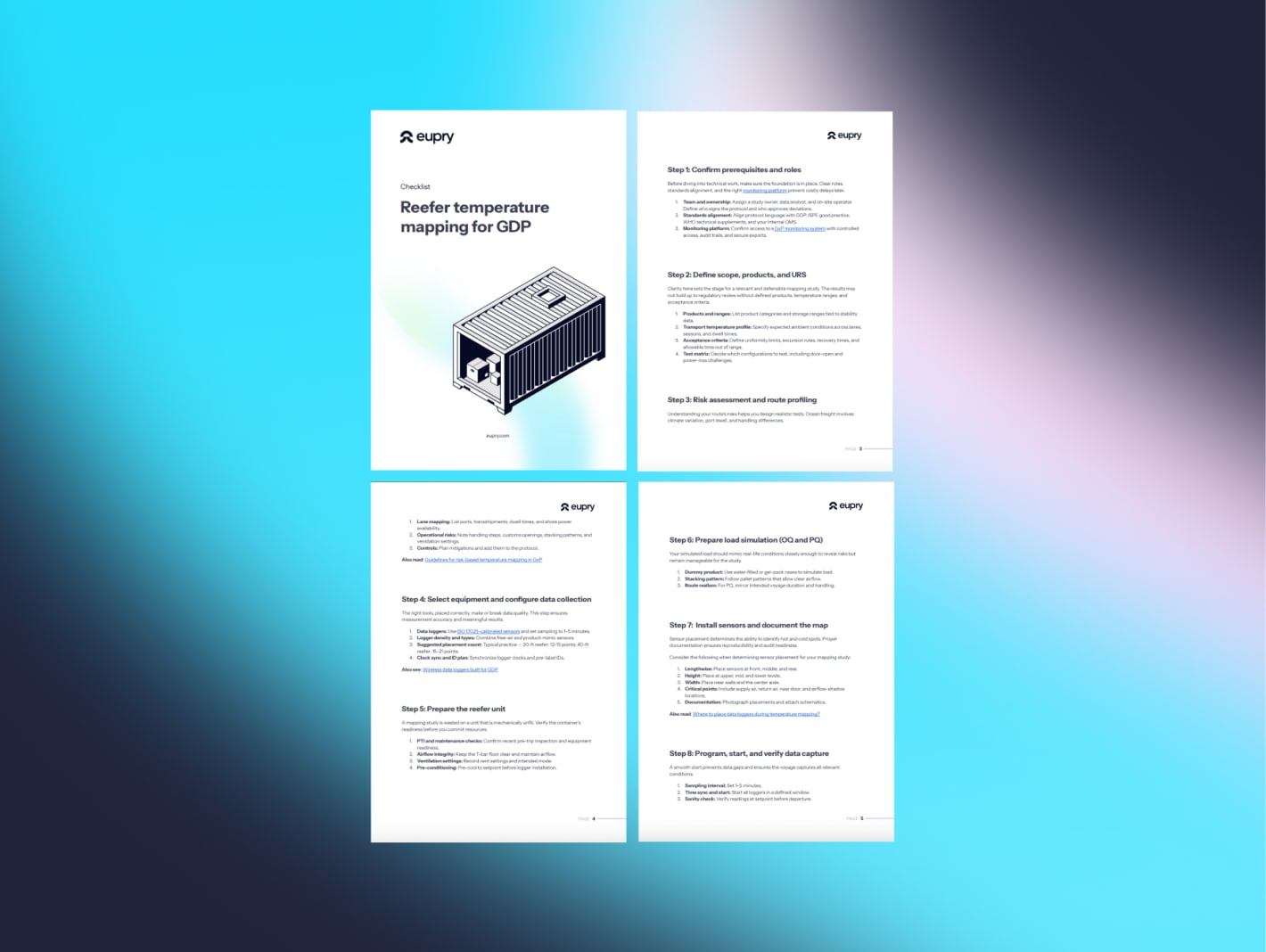GDP-compliant reefer temperature mapping for pharmaceuticals

Adam Hartmann-Kruckow
Step-by-step guidelines for GDP-compliant reefer container temperature mapping for pharmaceuticals – from what it is to best practices for sensor placement and typical issues.
Get a free, practical guideline to follow when planning your reefer mapping study.

Pharmaceutical companies are increasingly reconsidering sea freight for cold chain logistics due to rising air freight costs, sustainability targets, and improved reefer container technology. If you want to use reefer containers without risking product or audits, this guide shows exactly how to plan and execute GDP-compliant reefer temperature mapping, plus where it differs from trucks and warehouses.
This guide covers:
- What is reefer temperature mapping?
- Why consider reefer containers for pharmaceutical cold chain?
- How to perform GDP-compliant reefer temperature mapping
- How should sensors be placed inside a reefer?
- Common issues in reefer temperature mapping and how to prevent them
- How is reefer mapping different from truck or warehouse mapping?
Also see: Temperature mapping and validation solutions for reefers
What is reefer temperature mapping?
Short definition: Reefer temperature mapping is the process of verifying, through calibrated sensor data, that a refrigerated shipping container maintains required pharmaceutical storage temperatures uniformly during transit, in compliance with GDP, WHO, and ISPE standards.
Reefer temperature mapping involves placing calibrated data loggers inside the container to identify hot and cold spots, monitor stability, and evaluate performance during both normal operation and simulated risk scenarios. The documented results form the basis for IQ, OQ, and PQ qualification.
What is a reefer?
In pharmaceutical logistics, a reefer is a refrigerated shipping container used to transport temperature-sensitive medicines and vaccines under controlled conditions. It contains an integrated cooling unit capable of maintaining strict temperature ranges (e.g., +2°C to +8°C or +15°C to +25°C) during multi-modal transit, such as sea, road, and rail. GDP-compliant reefers must be validated through temperature mapping and IQ/OQ/PQ qualification to prove they can consistently protect product quality during long voyages and variable climate exposure.
15 steps of conducting GDP-compliant mapping studies of refrigerated containers.

Why use reefer containers for healthcare logistics?
Rising air freight costs, unstable flight networks, and sustainability targets are pushing pharmaceutical manufacturers, wholesalers, and 3PL providers to consider sea freight. Reefers can cut cost per pallet and reduce emissions for pharmaceutical shipments by sea, but only if you can prove they maintain product-specific temperature ranges under real-world conditions. That proof comes from a documented pharmaceutical reefer mapping and qualification program aligned with GDP, WHO, and ISPE guidelines.
Read more about temperature mapping in GxP.


Reefer temperature mapping for GDP
Use this step-by-step checklist to plan and execute a GDP-compliant temperature mapping of your reefer fleet.
How to perform GDP-compliant reefer temperature mapping
Pharmaceutical reefer temperature mapping verifies that a refrigerated shipping container can maintain uniform and stable product temperatures throughout its interior during transit. The process confirms performance during normal operation and recovery after stress events. Results are documented in an audit-ready report to support IQ, OQ, and PQ qualification. For process basics, see the ultimate mapping guide.
The key steps of reefer temperature mapping
The sequence below condenses a standard GDP reefer mapping checklist. It is route-aware and avoids common rework. If you need the full, tactical version, use the dedicated reefer mapping checklist and our on-site or remote options on wireless data loggers.
- Scope and criteria: Define temperature ranges and acceptance limits based on product stability data and risk assessments. Link these to your URS and regulatory standards.
- Risk and route profile: Document ports, dwell times, shore power usage, and climate zones to guide stress scenarios and loading plans.
- Equipment and sampling: Use ISO 17025-accredited calibration for all loggers and set justified intervals of 1–5 minutes. See ISO 17025.
- Unit readiness: Confirm PTI results, seals, drains, fans, ventilation settings, and pre-cooling before installing sensors.
- Placement and documentation: Position sensors to capture length, width, and height gradients – plus door, supply-air, return-air, and airflow-shadow areas. Photograph and record each location; see data logger placement guide.
- OQ challenges: Maintain steady state for defrost cycle coverage, then simulate door openings and brief power losses with defined recovery targets.
- PQ in real conditions: Run a loaded study on a representative shipping lane, logging ambient and operational data. Repeat on seasonal or route changes with elevated risk to maintain reefer container qualification for GDP.
- Analysis and reporting: Quantify uniformity, drift, and any temperature excursions. Relate hot or cold spots to airflow or handling practices and document CAPA in an audit-ready report.
How should sensors be placed inside a reefer during mapping studies?
Incorrect sensor placement can hide hotspots and weaken audit evidence in cold chain validation for reefers. Strategic positioning is crucial due to moving air, door-end exposure, and multi-climate voyages. Cover the evaporator end, center, and door end at multiple heights and near walls – and add supply and return air points for unit performance insight.
For a full guide, see "Where to place data loggers during temperature mapping?".
Common issues in reefer temperature mapping and how to prevent them
Most deviations in sea freight reefer mapping trace back to preventable issues. Address them early to improve study outcomes.
- Door-end exposure: Door openings during port or customs create temperature spikes. Mitigation: Test door openings during OQ and use pallet patterns to protect door-end product in PQ.
- Airflow shadows: Product stacked against walls or ceilings disrupts circulation. Mitigation: Keep T-bar floor channels and wall clearances open.
- Inadequate sampling: Long voyages require high-resolution data. Mitigation: Use justified 1–5 minute intervals and confirm logger memory capacity.
- Missing ambient context: Without external and unit air data, root cause analysis is weak. Mitigation: Log ambient, supply, and return air alongside internal sensors.
- Weak documentation: Missing sensor IDs, placement photos, or approvals weaken audit evidence. Mitigation: Follow ultimate mapping guide and store documentation in your QMS.
How is reefer mapping different from truck or warehouse mapping?
While truck and warehouse mapping are well established, reefer containers bring added challenges: multi-week voyages, route variability, and limited in-transit intervention. Acceptance criteria and stress events must reflect these constraints. If your network uses multiple transport modes, align your reefer mapping with truck mapping and warehouse protocols for consistent evidence.
Why invest in GDP-compliant reefer validation in logistics?
GDP-ready reefer capacity is scarce. Cold chain validation for reefers lets you win higher-value pharmaceutical contracts and offer cost-effective shipping options. Shippers lower landed costs while maintaining compliance; container owners tap into high-margin pharma markets.
Glossary: 4 key terms of reefer mapping
- GDP: "Good Distribution Practice" are standards for maintaining medicine quality during transport.
- IQ OQ PQ: Installation, Operational, and Performance Qualification – validation stages.
- Reefer container: Refrigerated shipping container for temperature-sensitive goods.
- Temperature mapping: Validation process to confirm uniform conditions in a controlled space.
Reefer mapping isn’t optional if you want pharma clients
Pharma manufacturers and healthcare logistics providers cannot risk multi-million-dollar product losses due to unqualified cold chain assets. Mapping and qualifying reefer containers is the foundation for winning and retaining pharmaceutical business in the evolving global logistics market.
With Eupry, you get:
- Reliable temperature mapping solutions built for healthcare logistics – in less time
- Confidence that your reefer containers meet GDP, WHO, and ISPE requirements
- Audit-ready documentation in days, not weeks
- The ability to offer validated pharma storage at competitive costs
For a quick start, download a temperature mapping catalog to learn how the mapping solutions work.

Frequently asked questions about reefer temperature mappings
Temperature mapping of reefers
Download a free step-by-step checklist to help you conduct compliant, efficient, and cost-saving temperature mapping of your reefers.

Next steps
If you want to self-execute, use a mapping kit and wireless temperature data loggers. For a turnkey solution, have the Eupry team design your URS and complete IQ/OQ/PQ - see more here IQ OQ PQ.
Ready to start? Contact our Eupry team today, and we will help you find the best solution for you.